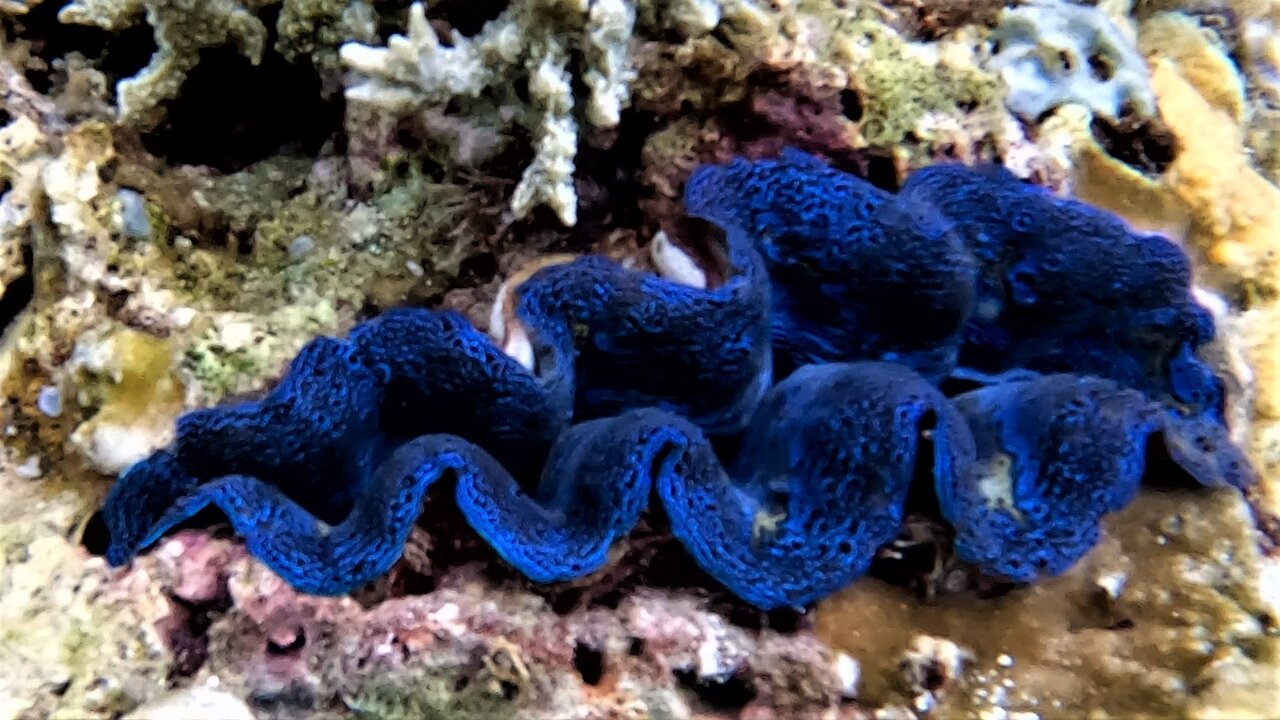Premium Only Content

Vividly colored giant blue clam beautifies the reef in Indonesia
There are many species of giant clams, with some specimens growing well over 1.5m (4.5 feet) across. They can weigh over 200kg (440lbs). Their shells and mantles can range from green or brown, to iridescent blues and purples. They are magnificent in their appearance but their ability to thrive and find nutrients is equally impressive.
The giant clams are the largest of the bivalve mollusks on the planet. They are filter feeders, straining the ocean water for zooplankton, yet they get most of their energy through a symbiotic relationship with algae. The clams cultivate algae in a special circulatory system, providing it with energy derived from sunlight, as well as oxygen from the photosynthesis. This symbiotic relationship is a relatively rare phenomenon in the animal kingdom.
Clams are hermaphrodites, allowing them to reproduce with any other clams, giving both individuals the opportunity for reproduction. Clams cannot self fertilize. They release sperm and eggs into the surrounding water, but amazingly this process is synchronized with other clams in the area through the release of a transmitter substance, called "spawning induced substance". Many clams will synchronize their contractions with other nearby clams to maximize fertilization. The contractions occur every 2-3 minutes over a period of a few hours. A single clam may release as many as 500 million eggs in one episode.
Clams have photoreceptors in their mantles that allow them to detect changes in light above. This signals them that a predator is near and they close to avoid their flesh being eaten. They have no true eyes and they are unlikely to respond to threats that do not involve sudden changes in water currents or light. A scuba diver passing over a clam will cause it to close.
These clams have been the victims of misunderstanding and fear, being dubbed "killer clams" or "man-eating clams". Legends tell of people being trapped by these clams and drowning. The clams are not capable of aggression and they close simply for defense. The shells close so slowly that it would take severe negligence to become trapped by one. The largest of the clams are not capable of fully closing their shells. It is highly unlikely that any clam has ever caused the death of a human.
Extensive harvest for aquarium trade and food have decreased the clam populations in the past few decades. They are considered a delicacy in Japan, France, and some Pacific islands.
These clams are a delightful sight for scuba divers and underwater explorers. This beauty was filmed near Komodo Island in Indonesia.
-
 0:28
0:28
WildCreatures
19 days ago $0.79 earnedBaby Capybara Yawns and Falls Asleep Under His Mother's Watchful Eye
2.71K3 -
 LIVE
LIVE
iCkEdMeL
54 minutes agoBOMBSHELL: Shooter’s Trans Partner Helped Take Him Down
1,126 watching -
 1:42:45
1:42:45
The Big Mig™
6 hours agoThe Islamic Invasion – The EU Has Fallen, A Warning For The USA |EP653
12.1K21 -
 LIVE
LIVE
Joker Effect
1 hour agoRUMBLE IN THE DEN 4 - Hungry fighters and NFL legend fight for respect
513 watching -
 44:37
44:37
Rebel News
1 hour ago🔴 LIVE NOW: Massive ‘Unite the Kingdom’ Rally in London ft. Tommy Robinson | UKrebels.com
17.3K32 -
 17:22
17:22
Professor Nez
1 hour ago💣BOMBSHELL: The Biden AutoPen Scandal JUST GOT REAL!
4.22K9 -
 LIVE
LIVE
I_Came_With_Fire_Podcast
10 hours agoRevelations from the Ukrainian Front Lines
350 watching -
 52:56
52:56
X22 Report
6 hours agoMr & Mrs X - Big Pharma Vaccine/Drug Agenda Is Being Exposed To The People - Ep 7
67.1K36 -
 1:41:59
1:41:59
THE Bitcoin Podcast with Walker America
11 hours ago $17.40 earnedThe Assassination of Charlie Kirk | Walker America, American Hodl, Erik Cason, Guy Swann
53.9K31 -
 21:33
21:33
marcushouse
5 hours ago $1.19 earnedSpaceX Just Revealed the Plan for Starship Flight 11! 🚀
20.5K7